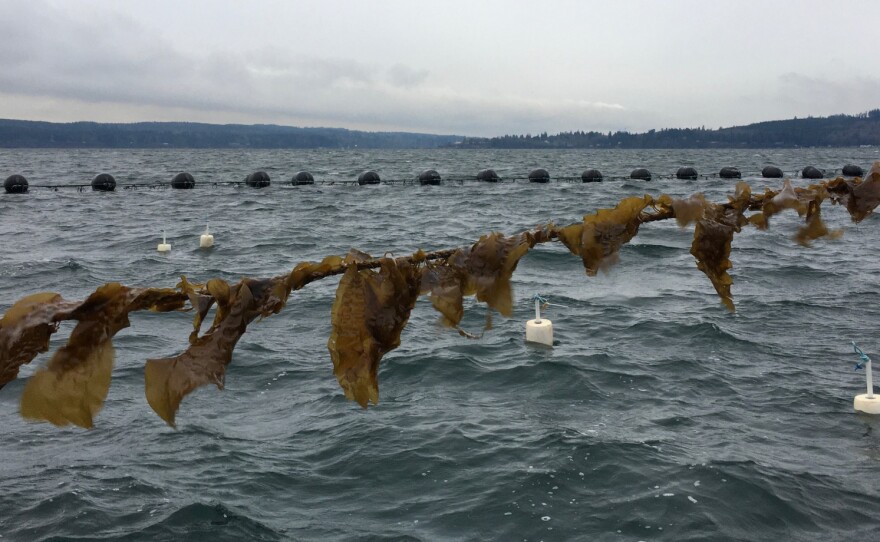As seaweeds grow in the ocean, they naturally pull carbon dioxide from the water for photosynthesis, much as trees pull CO2 from the air. Many people in western Washington see an opportunity in that.
Shellfish growers here have struggled with ocean acidification, which is increasing along with climate change and can prevent baby oysters from forming their shells. So, one farm on the north end of Hood Canal has devoted five acres to an experiment that is now licensed as a commercial operation. They're growing kelp along with oysters on lines to see if that co-culture can benefit both crops.
It's been working well, says Charlie Delius, the farm manager at Hood Canal Mariculture.
“Last year, we had pretty good success with the crop. Most of that’s being used for R and D to develop different food products that we’ve been working on for a while,” he says.
As he spoke, he stood at the helm of a skiff that ferried more than two dozen people to the farm so they could see how the seaweed and oyster lines are secured. Delius says although plastics are not in keeping with the ecological vibe many wannabe seaweed farmers hope to bring to the water, he’s learned using PVC pipes around some lines is a must to help the farm’s infrastructure hold up in the elements.
The lines have to withstand the strong wintertime currents in Hood Canal and not get tangled. The farm is using a leased area of about five acres, but the crops grow in only about two of those, ten to 20 feet below the surface.
Word is out about it. People have been flooding the researchers involved with inquiries. Washington Sea Grant convened a three-day workshop this week to give realistic answers to all the questions they and other researchers involved in the research have been getting.
Meg Chadsey, an ocean acidification specialist at Washington Sea Grant, says the motivation is a mix of excitement about getting in on a new ocean crop that is healthy to eat and fits in with the trend toward more plant-based diets, and the desire to grow something that could actually help address ocean acidification or other forms of water pollution that seaweeds absorb.

But she cautions that growing seaweed is definitely not a magic bullet the way many people seem to think or hope.
“It can be beneficial very locally. And by that I mean: right around a kelp bed, you might see an improvement in seawater chemistry. So, things that were living in that space would be protected somewhat from ocean acidification.”
Thirty people took part in the workshop and twice as many applied. One of the first things they learned is that right now, there are multiple agencies — state, federal and tribal — that they'll have to work with to set up their own seaweed farm.
“Oh my God! Ten different government agencies that I have to go through, to get the permit process — and it may take more than a year! …if I’m lucky,” said Chong Kim, after the first day of the workshop.
Kim recently retired early from a long career running his own restaurant in Seattle and was looking for a next act in life.
He heard a story on the radio about how growing seaweed locally could help with ocean acidification. He thought it might be too good to be true.
Kim came here as a teenager from Korea, but he’s never forgotten the central role seaweed plays in Korean culture. He says broth from seaweed is almost like mother’s milk.
“The very first food after labor (for a mom) is a seaweed soup. So, in a way, that’s the first thing tasted — seaweed — when you’re first born,” he says.
“And when it’s your birthday, you eat seaweed soup — that’s just part of the culture.”
He says what he’s learned this week does make growing seaweed sound much more daunting than he imagined. But he’s not giving up. He’s working part-time as a wine steward and wants to keep exploring ideas for boosting demand, maybe by helping growers find some artisanal strains here.
And also, he says, with his long food service background and love of seaweed, “make it tasty!"
Washington Sea Grant cautions local growers that startup costs here right now could range from $20 to $100,000 to cover everything from equipment to fees for consulting, leasing and permitting. Over time, though, they’re hopeful that the agencies will collaborate to develop a less costly process to “on board” new growers.












